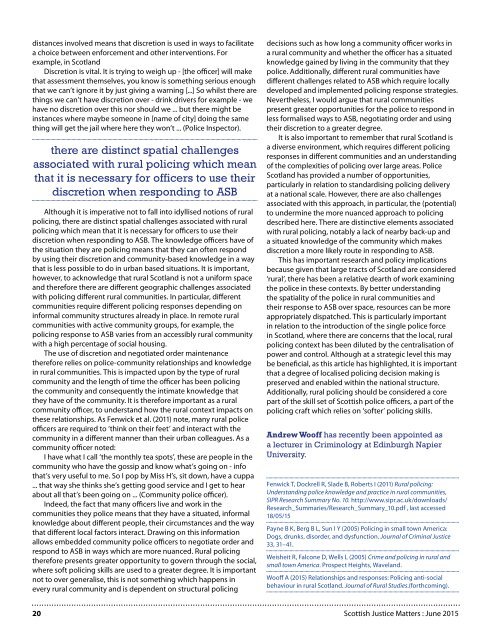Iy9yJ5
Iy9yJ5
Iy9yJ5
You also want an ePaper? Increase the reach of your titles
YUMPU automatically turns print PDFs into web optimized ePapers that Google loves.
distances involved means that discretion is used in ways to facilitatea choice between enforcement and other interventions. Forexample, in ScotlandDiscretion is vital. It is trying to weigh up - [the officer] will makethat assessment themselves, you know is something serious enoughthat we can’t ignore it by just giving a warning [...] So whilst there arethings we can’t have discretion over - drink drivers for example - wehave no discretion over this nor should we ... but there might beinstances where maybe someone in [name of city] doing the samething will get the jail where here they won’t ... (Police Inspector).there are distinct spatial challengesassociated with rural policing which meanthat it is necessary for officers to use theirdiscretion when responding to ASBAlthough it is imperative not to fall into idyllised notions of ruralpolicing, there are distinct spatial challenges associated with ruralpolicing which mean that it is necessary for officers to use theirdiscretion when responding to ASB. The knowledge officers have ofthe situation they are policing means that they can often respondby using their discretion and community-based knowledge in a waythat is less possible to do in urban based situations. It is important,however, to acknowledge that rural Scotland is not a uniform spaceand therefore there are different geographic challenges associatedwith policing different rural communities. In particular, differentcommunities require different policing responses depending oninformal community structures already in place. In remote ruralcommunities with active community groups, for example, thepolicing response to ASB varies from an accessibly rural communitywith a high percentage of social housing.The use of discretion and negotiated order maintenancetherefore relies on police-community relationships and knowledgein rural communities. This is impacted upon by the type of ruralcommunity and the length of time the officer has been policingthe community and consequently the intimate knowledge thatthey have of the community. It is therefore important as a ruralcommunity officer, to understand how the rural context impacts onthese relationships. As Fenwick et al. (2011) note, many rural policeofficers are required to ‘think on their feet’ and interact with thecommunity in a different manner than their urban colleagues. As acommunity officer noted:I have what I call ‘the monthly tea spots’, these are people in thecommunity who have the gossip and know what’s going on - infothat’s very useful to me. So I pop by Miss H’s, sit down, have a cuppa... that way she thinks she’s getting good service and I get to hearabout all that’s been going on ... (Community police officer).Indeed, the fact that many officers live and work in thecommunities they police means that they have a situated, informalknowledge about different people, their circumstances and the waythat different local factors interact. Drawing on this informationallows embedded community police officers to negotiate order andrespond to ASB in ways which are more nuanced. Rural policingtherefore presents greater opportunity to govern through the social,where soft policing skills are used to a greater degree. It is importantnot to over generalise, this is not something which happens inevery rural community and is dependent on structural policingdecisions such as how long a community officer works ina rural community and whether the officer has a situatedknowledge gained by living in the community that theypolice. Additionally, different rural communities havedifferent challenges related to ASB which require locallydeveloped and implemented policing response strategies.Nevertheless, I would argue that rural communitiespresent greater opportunities for the police to respond inless formalised ways to ASB, negotiating order and usingtheir discretion to a greater degree.It is also important to remember that rural Scotland isa diverse environment, which requires different policingresponses in different communities and an understandingof the complexities of policing over large areas. PoliceScotland has provided a number of opportunities,particularly in relation to standardising policing deliveryat a national scale. However, there are also challengesassociated with this approach, in particular, the (potential)to undermine the more nuanced approach to policingdescribed here. There are distinctive elements associatedwith rural policing, notably a lack of nearby back-up anda situated knowledge of the community which makesdiscretion a more likely route in responding to ASB.This has important research and policy implicationsbecause given that large tracts of Scotland are considered‘rural’, there has been a relative dearth of work examiningthe police in these contexts. By better understandingthe spatiality of the police in rural communities andtheir response to ASB over space, resources can be moreappropriately dispatched. This is particularly importantin relation to the introduction of the single police forcein Scotland, where there are concerns that the local, ruralpolicing context has been diluted by the centralisation ofpower and control. Although at a strategic level this maybe beneficial, as this article has highlighted, it is importantthat a degree of localised policing decision making ispreserved and enabled within the national structure.Additionally, rural policing should be considered a corepart of the skill set of Scottish police officers, a part of thepolicing craft which relies on ‘softer’ policing skills.Andrew Wooff has recently been appointed asa lecturer in Criminology at Edinburgh NapierUniversity.Fenwick T, Dockrell R, Slade B, Roberts I (2011) Rural policing:Understanding police knowledge and practice in rural communities,SIPR Research Summary No. 10. http://www.sipr.ac.uk/downloads/Research_Summaries/Research_Summary_10.pdf , last accessed18/05/15Payne B K, Berg B L, Sun I Y (2005) Policing in small town America:Dogs, drunks, disorder, and dysfunction. Journal of Criminal Justice33, 31–41.Weisheit R, Falcone D, Wells L (2005) Crime and policing in rural andsmall town America. Prospect Heights, Waveland.Wooff A (2015) Relationships and responses: Policing anti-socialbehaviour in rural Scotland. Journal of Rural Studies.(forthcoming).20 Scottish Justice Matters : June 2015


